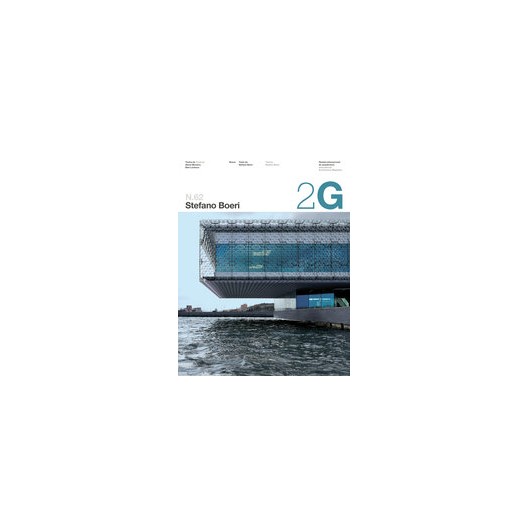- Rupture de stock



Stefano Boeri est né en 1956. Il est reconnu pour être à la fois architecte et éditeur.
Depuis 2007, il est à la direction de la revue d’architecture Abitare.
Il tient son agence à Milan, Stefano Boeri Architetti, qui travaille principalement sur l’architecture et le projet urbain.
Il enseigne le design urbain à l’école polytechnique de Milan et il est un professeur invité à l’Université d’Harvard.
 Garanties sécurité
Garanties sécurité
(à modifier dans le module "Réassurance")
 Politique de livraison
Politique de livraison
(à modifier dans le module "Réassurance")
 Politique retours
Politique retours
(à modifier dans le module "Réassurance")
To go looking for the person whose projects appear in this magazine in his studio would be a waste of time. Not that the cosy apartment on Via Donizetti is empty: there are two dozen employees working in it. The “senior guys” here are barely more than forty years old. From time to time, one or other of them occupies the master’s office/study. This small room with a desk and bookshelves all along one wall serves sometimes as a meeting room, sometimes as a place in which people can work in peace and quiet, away from the other rooms. And although Stefano Boeri lives somewhere nearby, he has not been seen in his studio for a long time —in fact, since the middle of spring 2011, when he took up his post as cultural advisor to Milan City Hall.
In order to meet this architect-turned-politician, you have to leave the tranquil 19th-century bourgeois neighbourhood of his studio and head for the impressive Duomo. The cultural advisor’s office is situated in the east wing of the Palazzo Reale. Our meeting is scheduled for 12 noon. I sit in the reception area, an elongated space with walls covered in pinkish stucco. It is crowned by a cylindrical vault painted with trompe-l’oeil rhomboid caissons. There is silence except for the noise of a fan. A long Rococo sofa (gilded frame, purple upholstery) is shared by a number of other people in addition to us. Their intelligent, animated faces remind me of paintings by Italian old masters and leave me with no doubt that we are in the company of eminent cultural figures. Next to the sofa is a snow-white-marble sculpture of a weeping angel —something in between a Maillol and a Botero. On the stand opposite are posters for La Scala productions such as Falstaff, Carmen, Madam Butterfly, and so on.
And then Stefano Boeri appears, surrounded by assistants. He quickly shakes hands with everyone. We proceed single-file into his study, and the eminent cultural figures again freeze into position on the sofa. As soon as everyone has sat down, Stefano’s mobile phone rings. “Renzo Piano,” he says quietly, looking at the display on his Blackberry. And then a loud and confident “Pronto!” resounds from somewhere far away, and he’s no longer anywhere to be seen: he prefers to talk to the pioneer of high-tech without witnesses. This gives us time to look around. It’s immediately obvious that we are not in a studio, but a palace. This office is much more spacious than the other. Through the window we can see the buttresses of Milan Cathedral. The antique tables—a desk and a meeting table—stand next to remakes of furniture by Mies van de Rohe. In the corner there are three flags —for Lombardy, Italy and the European Union. All the table-tops are covered with objects of various kinds: a monograph on Claude Monet squashes a catalogue from an exhibition by Anish Kapoor; a metal tin of boiled sweets lies next to a bottle of Beluga vodka still in its airport wrapper; glossy interior-design magazines rub shoulders with authoritative publications on architecture. Is this just the typical eclecticism that distinguishes modern political life? Or is the office of Milan’s Cultural Advisor a European space in miniature, the kind of space on which the subject of this article is always reflecting?
ntroductions
Stefano Boeri’s dual world
Alexei Muratov
From above, the tumult—under the paving stones, the beach
Bart Lootsma
Works and projects
Geothermal power station, Bagnore
Rizzoli Corriere della Sera headquarters, Milan
Social housing, Seregno
Shopping centre, Cinisello Balsamo
Reclamation of the ex-military arsenal, La Maddalena
Art Incubator, Milan
Meet Design exhibition, Rome and Turin
Casa .italo passenger hubs
Centre Régional de la Méditerranée, Marseilles
Vertical Forest, Milan
Master plan, Expo Milan 2015
Casa Bosco: model for social housing in wood, Milan
Housing, Astana
Wangfujing complex, Beijing
D4 District master plan, Skolkovo
BioMilano
Biography
Nexus
Change countries… Stay in Italy
Stefano Boeri
Fiche technique